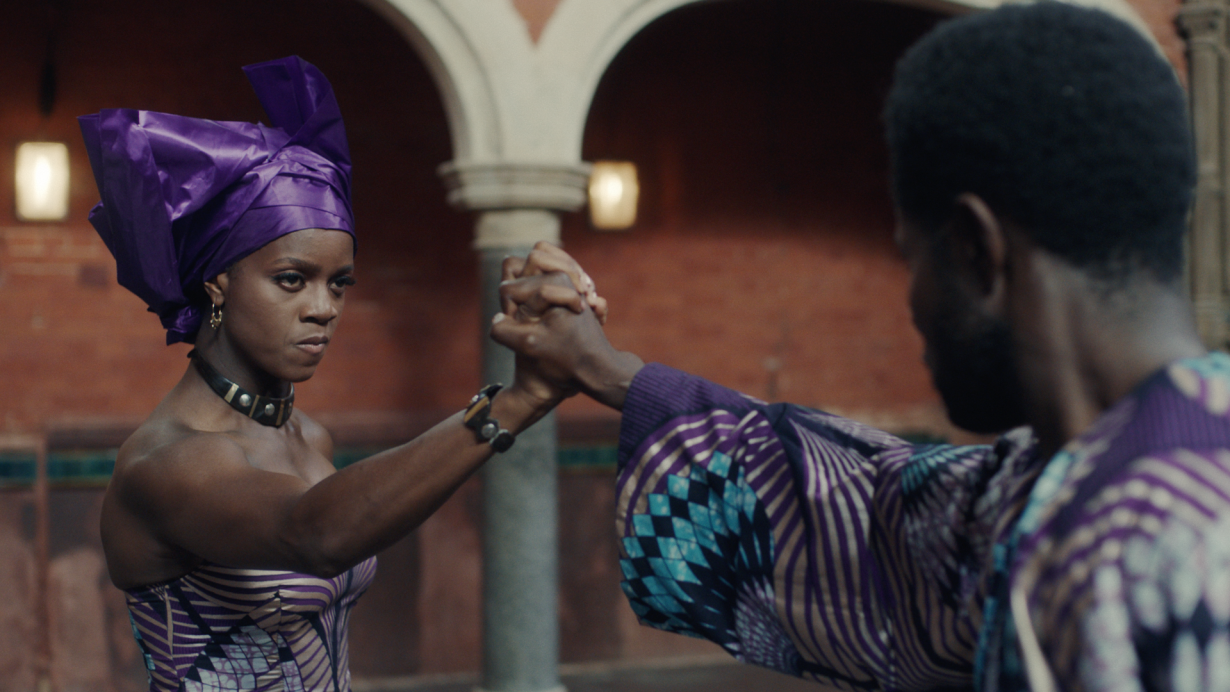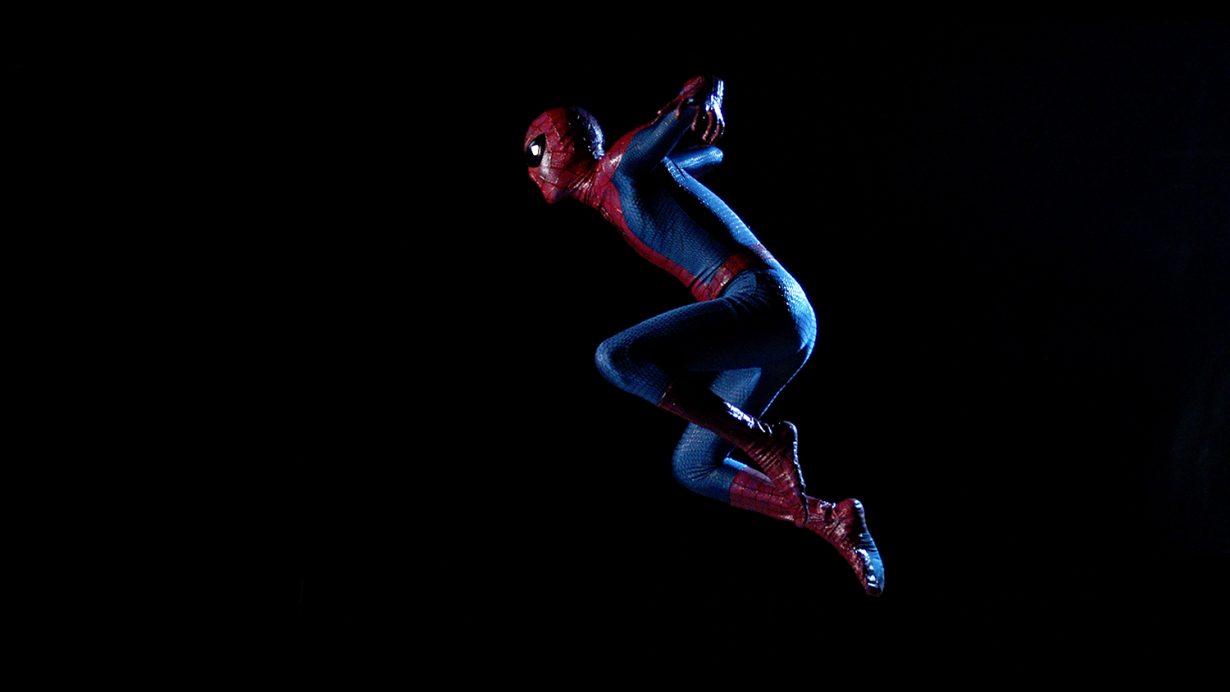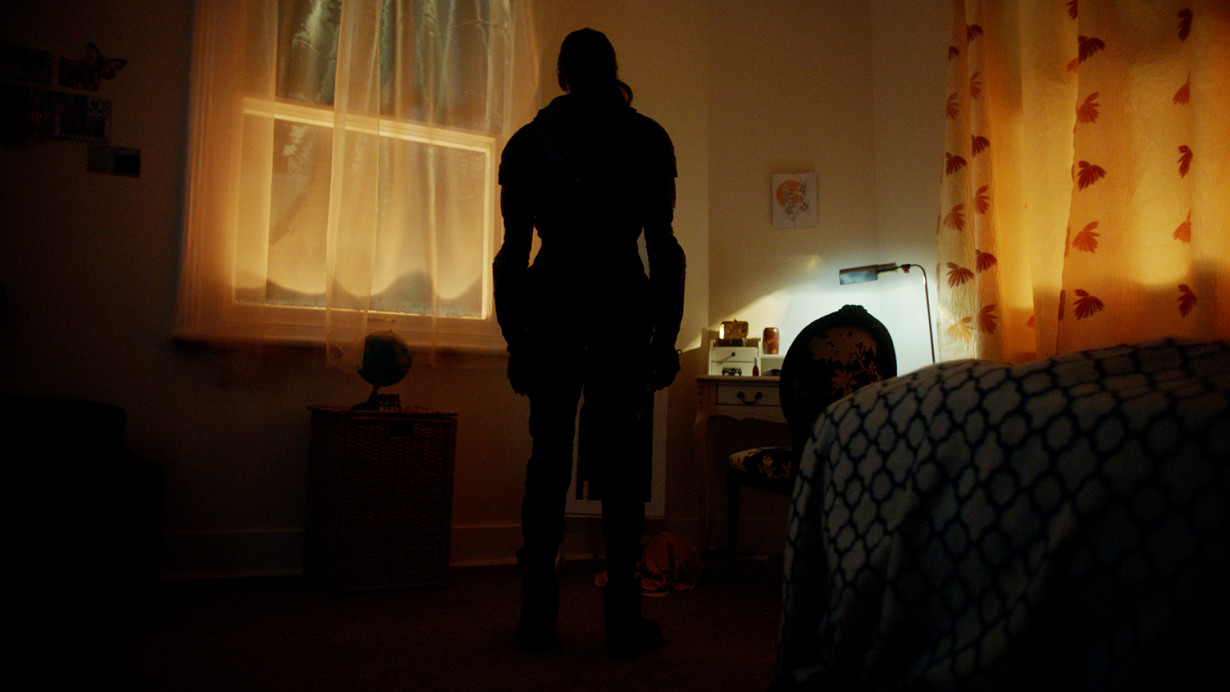Mixing the production values of mainstream Hollywood movies with actors drawn from marginalised communities in Britain and a deep, deep love of martial-arts films, Trinity gathers a trilogy of films by Bolton-born Hetain Patel in a setting that gives something of the feel of a multiplex cinema experience. Aided by the John Hansard Gallery’s architecture (a contemporary purpose-built arts complex with a glazed corner facade, to which it relocated in 2018) and its location next to the shops, bars and restaurants of Southampton’s city centre. Oh, and an artist-designed giftshop – part exhibit, part marketplace – in the show.

6 min 32 sec. Courtesy John Hansard Gallery, Southampton
In the two-channel installation The Jump (2015), Patel, clothed in a very convincing homemade Spider-Man costume, performs one of the character’s signature crouching leaps, filmed in ultra-slow motion. One channel features Spider-Man leaping through a foggy night sky, just like in the movies; the other, screened on the reverse of the first, locates the same scene in Patel’s grandmother’s Bolton living-room, where a sofa serves as the springboard and an ornate carpet as a landing pad, while 17 members of the artist’s family, dressed in decorated saris, kurtas and other types of Indian formal wear, and somewhat crushed into the space, witness the act. Posed as if waiting to join the collection of family photographs that decorate the matriarch’s walls. The whole has the feel of schoolboy fantasy meets reality, while conjuring notions of costume and identity (some of those clothed in the Indian formalwear are white), escapism, transformation and appropriation. And the potential to leave all that behind when you don a suit and a mask. But just for a moment, however slowed down and suspended that moment might be.

The second film in the trilogy, Don’t Look at the Finger (2015), is at once more expansive and exotic. The title derives from one of Bruce Lee’s catchphrases in Enter the Dragon (1973) and the action centres on a balletic fight scene choreographed Hong Kong-style with a touch of contemporary dance, a fusion broadly identifiable with movies such as The Matrix (1999) that borrow from the genres. While the action may derive from East Asia, the video’s two main protagonists are Black and dressed in brightly coloured, luxurious robes influenced by West Africa. Asian moves and African aesthetics. A man and a woman, the actors seem to be engaged in what may be a ceremony that’s part of a formal or arranged marriage, witnessed by similarly dressed attendants. The action plays out in a choreographed fight in which the pair seem to be feeling each other out and testing who has the upper hand in the union’s power dynamics. A battle of the sexes. All of it conducted without dialogue and purely through the actions of the body and the hands. It’s not just the bodies that perform but the clothes that cover them; after each ‘round’, the attendants adjust the costumes so that they take on a different pattern and shape. You might see the whole as an attempt to place the Black body centre stage in a blockbuster-style production, or as an attempt to test the hybrid cultural references and aesthetics that are so much a part of real life in the urban West and in the often unreal and unrepresentative world of the mainstream cinema that those urbanites consume. Although this is notably an aesthetic, and a blend, that has since been replicated to some degree in an actual blockbuster: Marvel Studio’s Black Panther (2018). And presumably for many people seeing Patel’s work for the first time, that connection is going to appear to be the other way around. Perhaps there’s a satisfaction in getting there first; perhaps there’s a satisfaction in the fact that Patel’s motivations are not commercial (Don’t Look at the Finger was commissioned by Film and Video Umbrella with Manchester Art Gallery and QUAD, and supported by the Jerwood Choreographic Research Fund). But then there’s the shop.

6 min 32 sec. Courtesy John Hansard Gallery, Southampton
A statement by the artist displayed at its entrance includes the line: ‘In the world where we – as marginalised people – are typically given the soap drama, EastEnders [a long-running UK soap opera, set in London’s ‘gritty’, working-class East End] treatment, rather than the big movie Batman treatment, we have to create our own’. Accordingly, Patel’s giftshop includes a range of clothing (unisex bomber jackets and shirts – you can buy them online), boxed action figures of characters from the three films (prototypes of products to come) and posters, postcards and tote bags (available from the museum shop). A mix, then, of revolution and capitalism; art and commerce. A critique of sorts, but representative of a desire to join the object of that critique as well.

If the first two works seem not far removed from documentary records of dance performances, the final film in the trilogy, a new work, Trinity (2021), represents an evolution of sorts. Featuring a more extended plot, verbal (a mix of Gujarati and English) as well as nonverbal dialogue and multiple locations and character relationships, the video centres on a young British Indian woman (played by Vidya Patel, a dancer and performer trained in the classical Kathak dance form) and her encounters with a motor mechanic (played by deaf dancer and performer Raffie Julien) and her mother, who we learn at the beginning of the film was told that the souls of their ancestors lie sleeping in women’s bodies. The work riffs off the two younger women, with the mother, her home filled with avatars of Hindu deities (the opening shot lingers on a garlanded image of Saraswati), attempting to organise an arranged marriage for her daughter as she supervises and critiques the latter’s Kathak dance practice. The daughter’s bedroom is decorated with Transformer-style toys, and it is within this space that she constructs a superhero costume of her own. She has rage. Taken out at one point on a car that nearly runs her off the road, which she keys and steals. From there she meets the deaf mechanic, with whom she struggles to communicate. Eventually the pair fight, in the manner of the performers in Don’t Look at the Finger, gradually reaching some form of understanding through a seemingly universal language combining sign language, Tai Chi and other martial-arts moves, as their bodies flickeringly shapeshift through the multiethnic, variously sexed bodies of what we presume are their ancestors or representative of some of the cultural forms they appropriate.

To a greater extent than its predecessors, Trinity rises above its slick choreography and seductive aesthetics – in part because of the evident trouble, conflict and frustration in the main character’s soul as she attempts to find a place in the multiple realities she inhabits. Yet at the same time you could see it as little more than an expanded and complexified form of the cultural confrontation of The Jump, and the exploration of body language in Don’t Look at the Finger. While the trilogy certainly moves, develops, is perfectly sumptuous in the production, performance and staging of each individual film, and makes a point about the nature of tradition, access to representation and the hybrid reality of urban cultural landscapes, it’s not so clear that it actually goes anywhere.
Hetain Patel, Trinity, John Hansard Gallery, Southampton 3 August – 30 October
